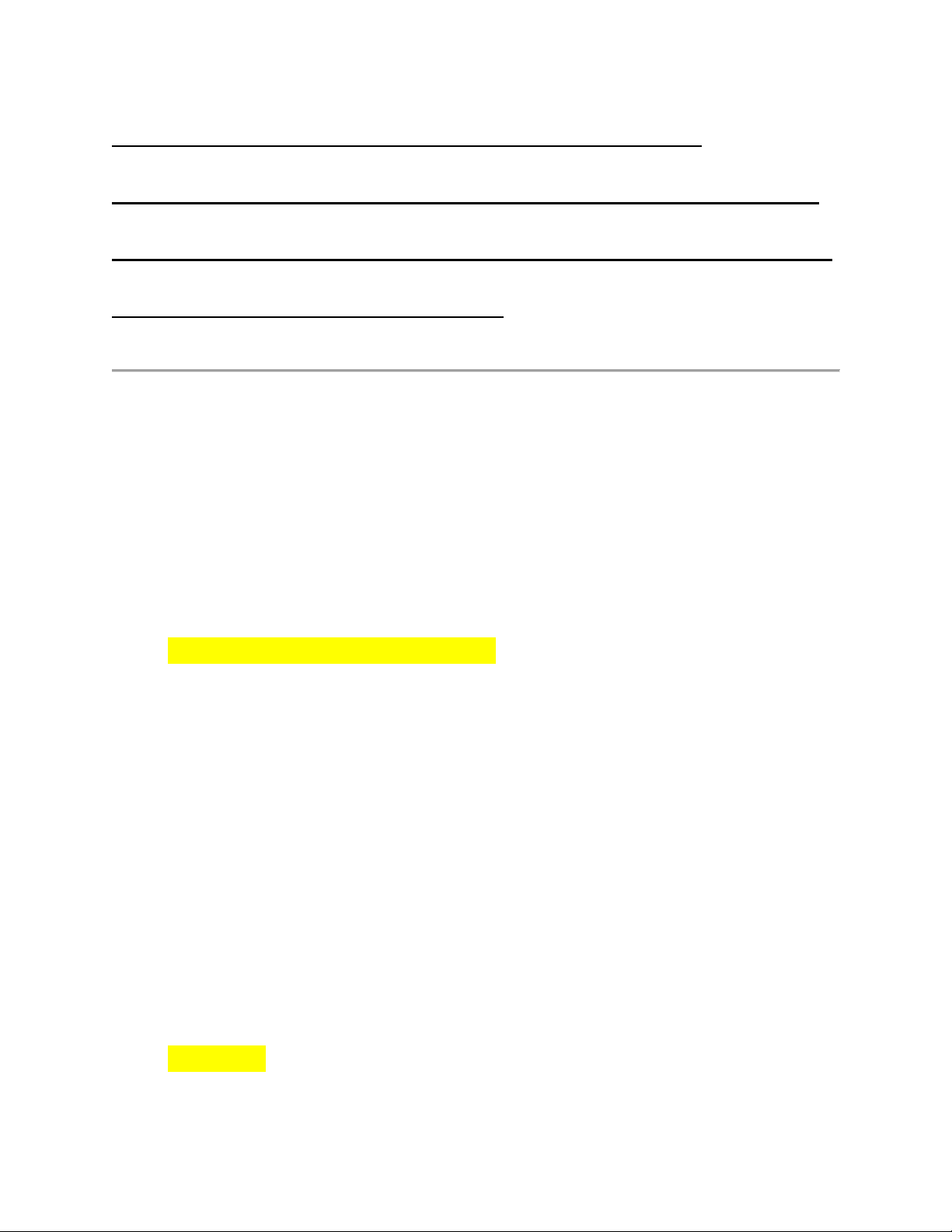
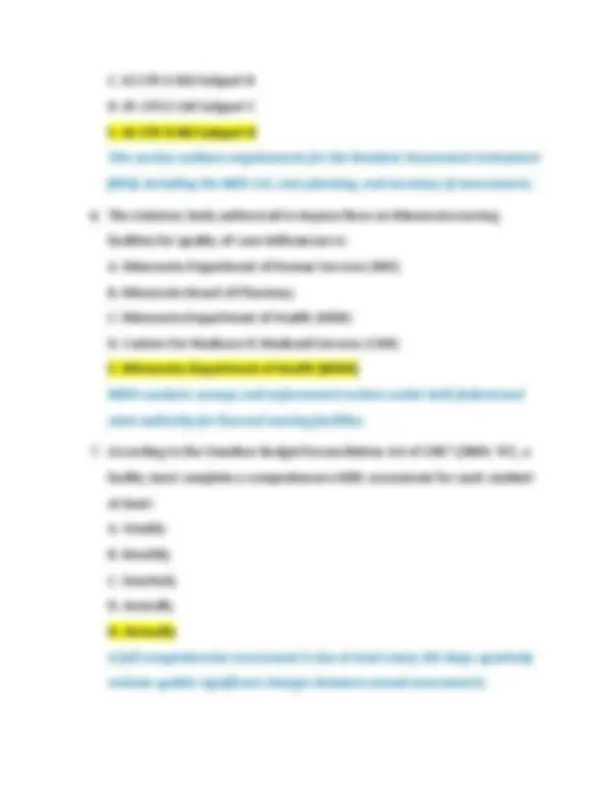
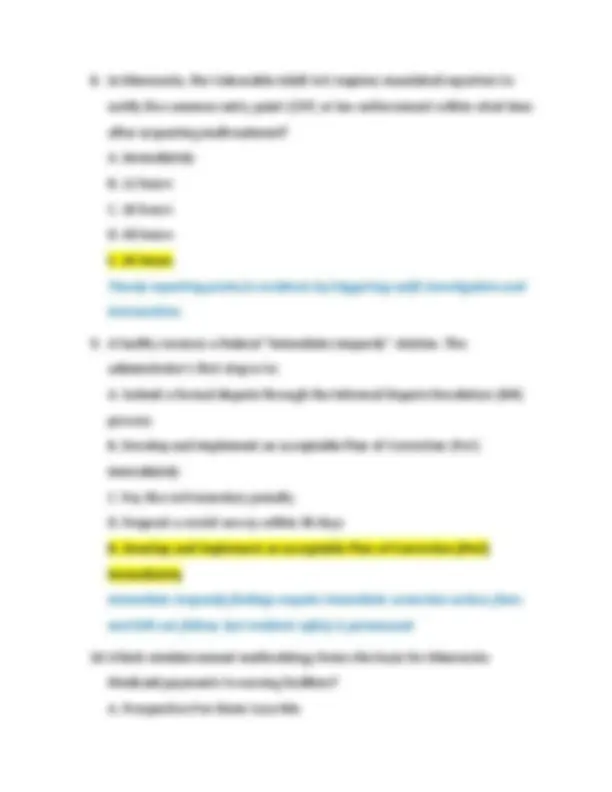
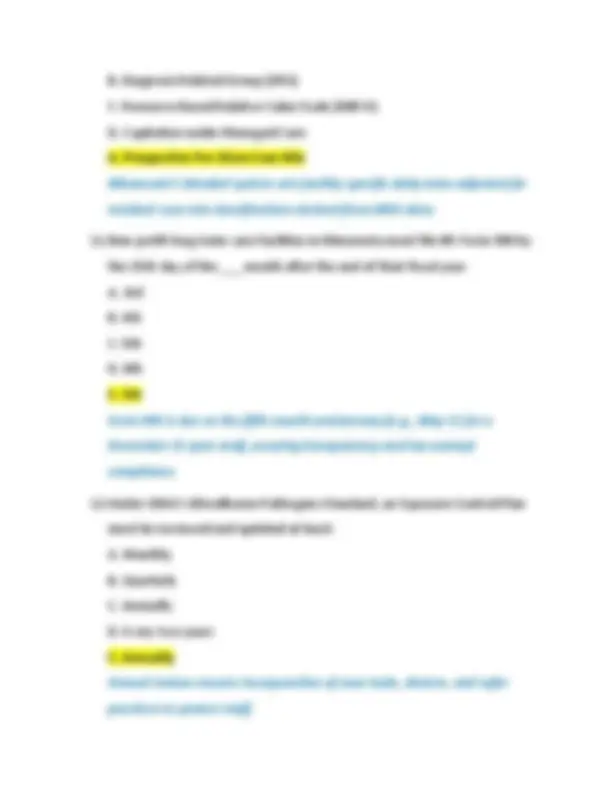
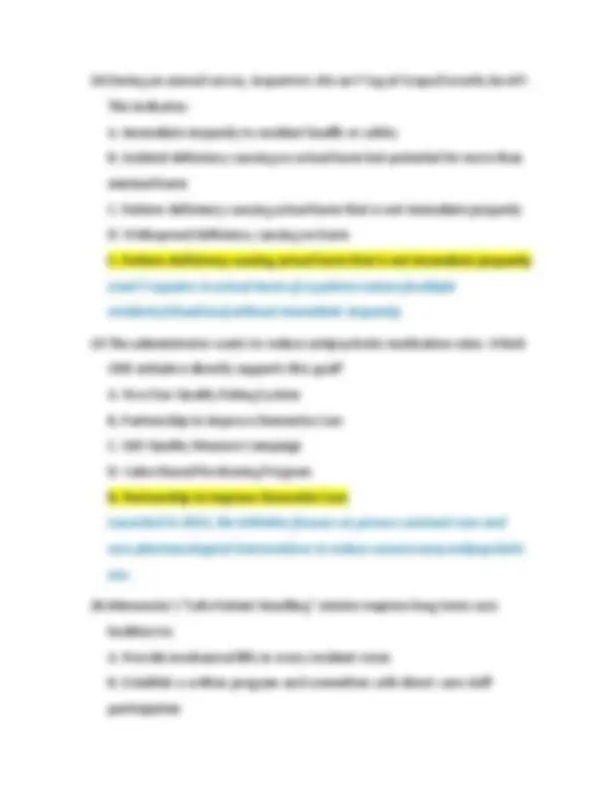
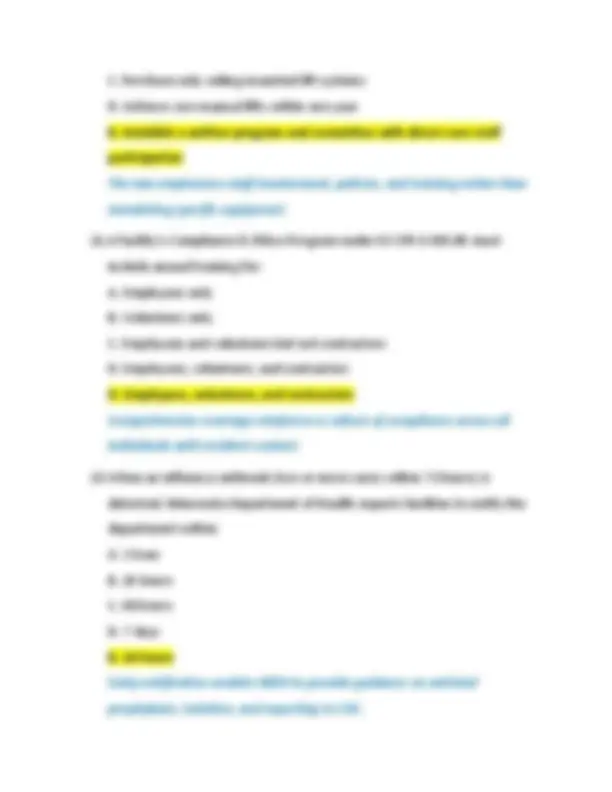
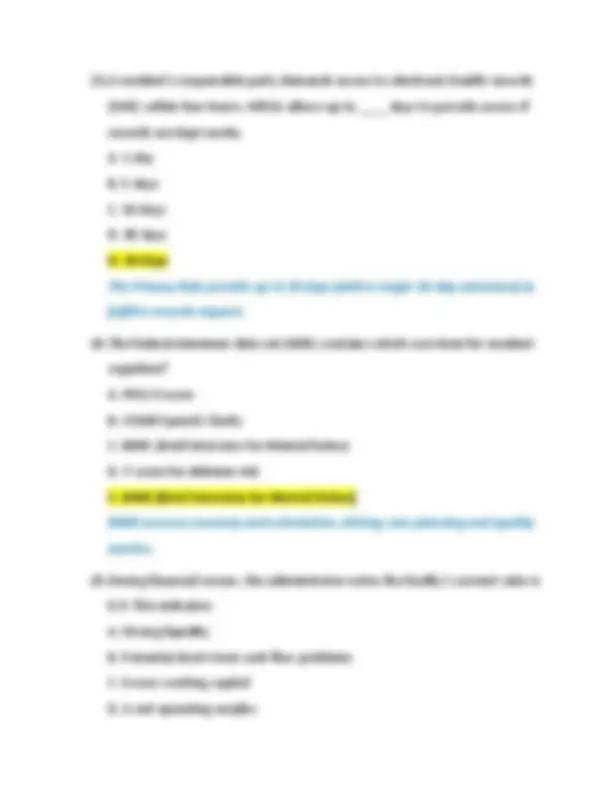
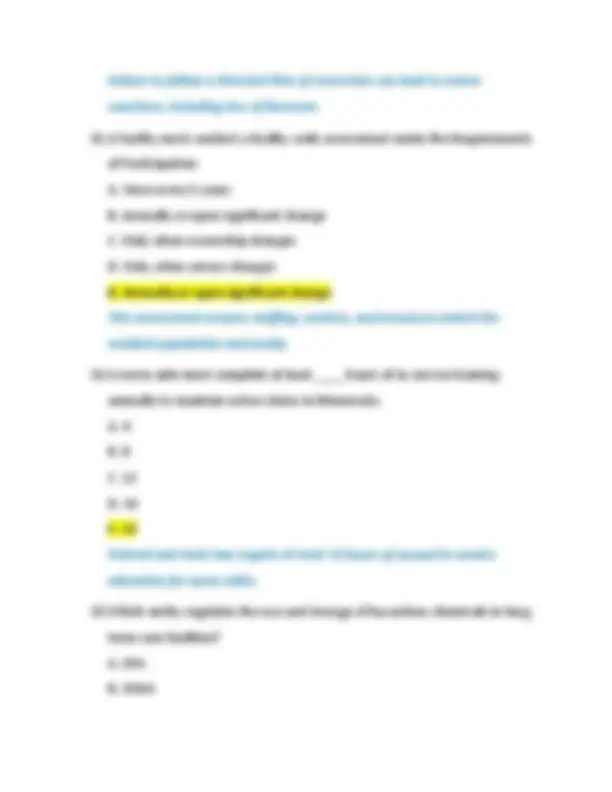
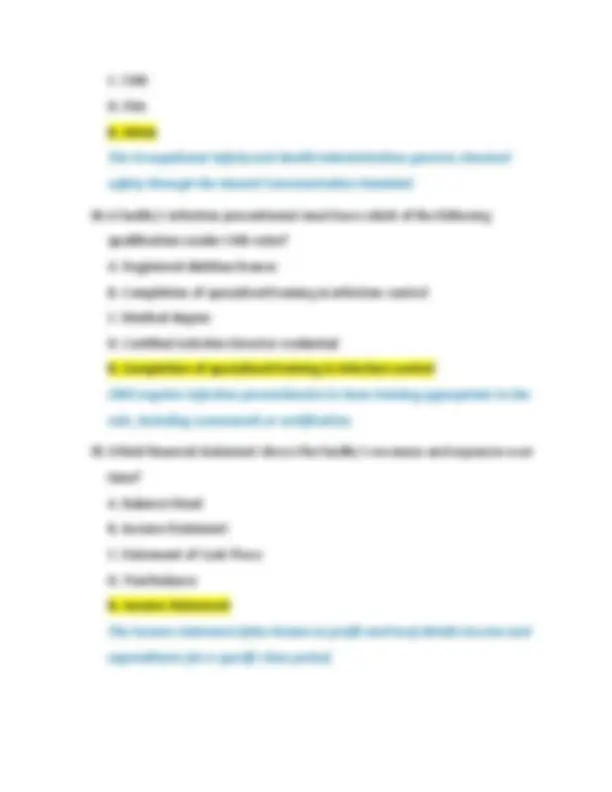
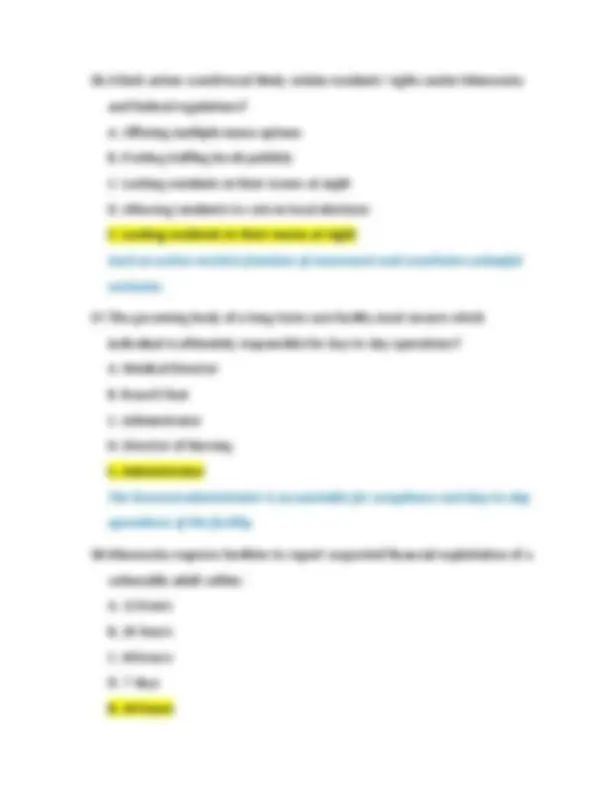
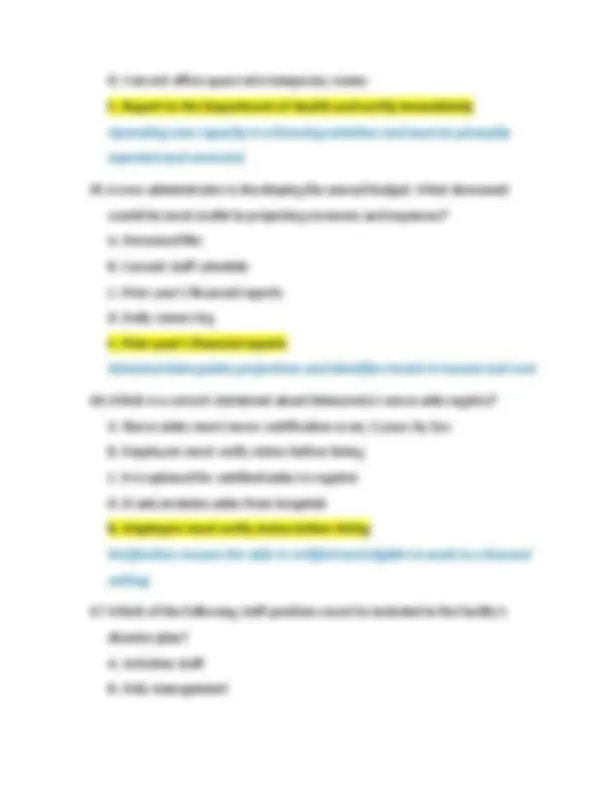
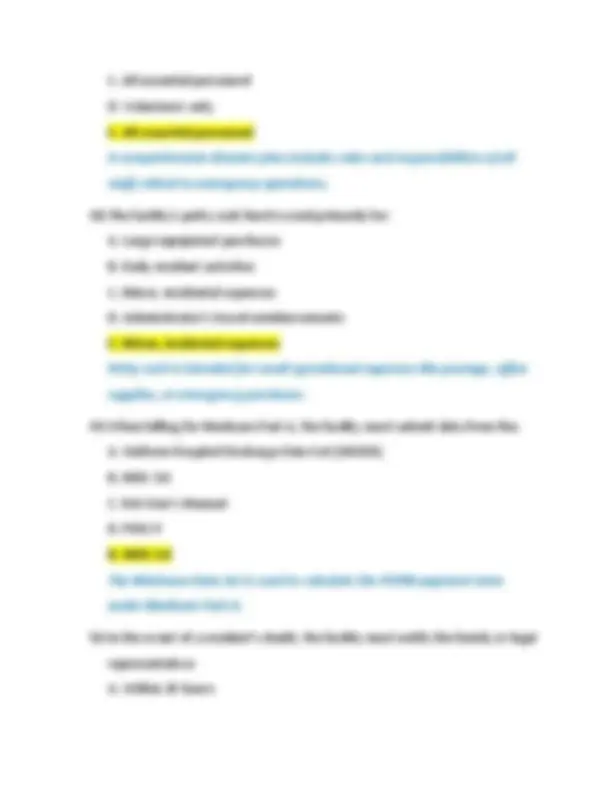
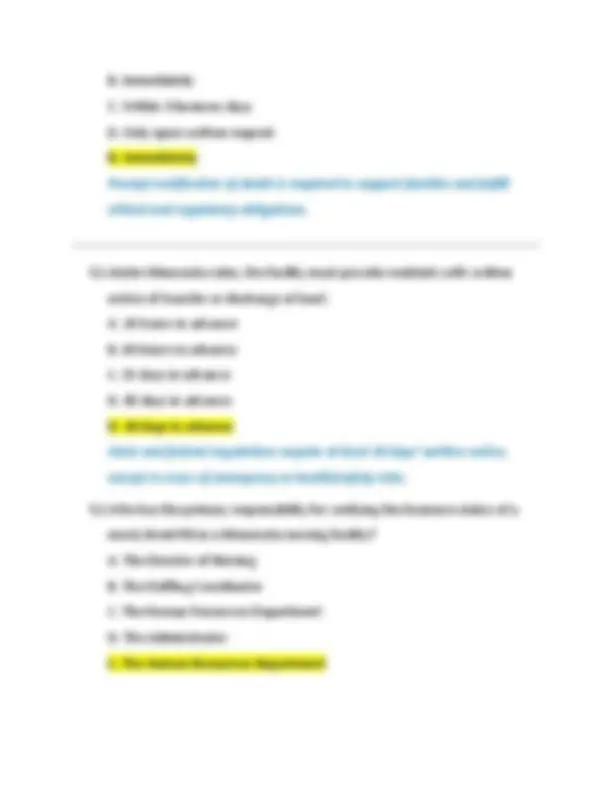
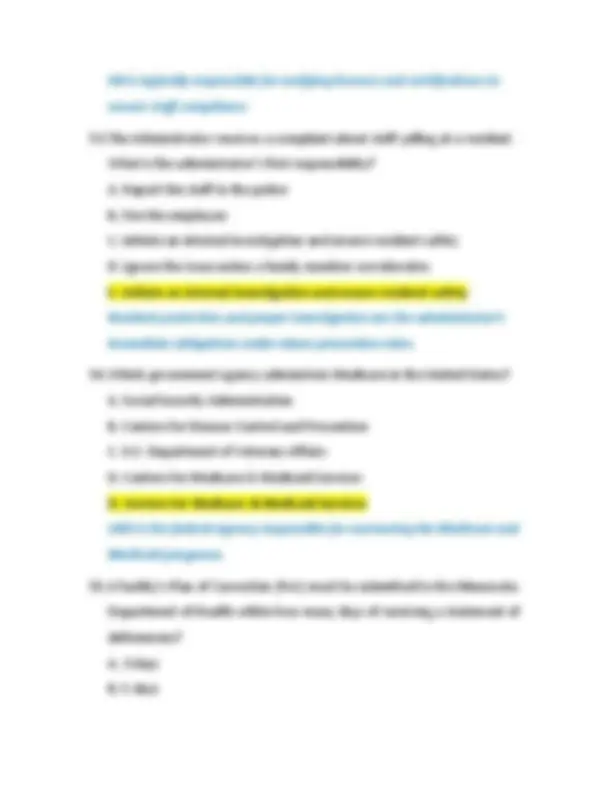
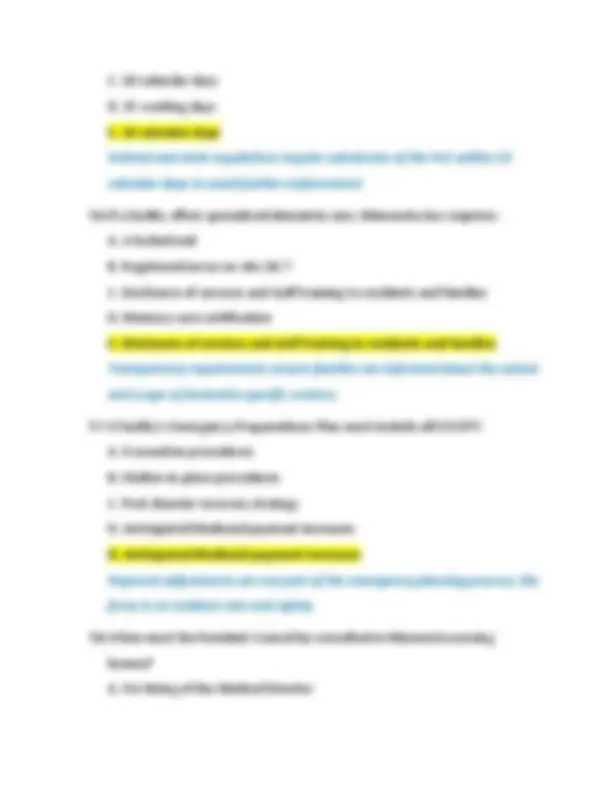
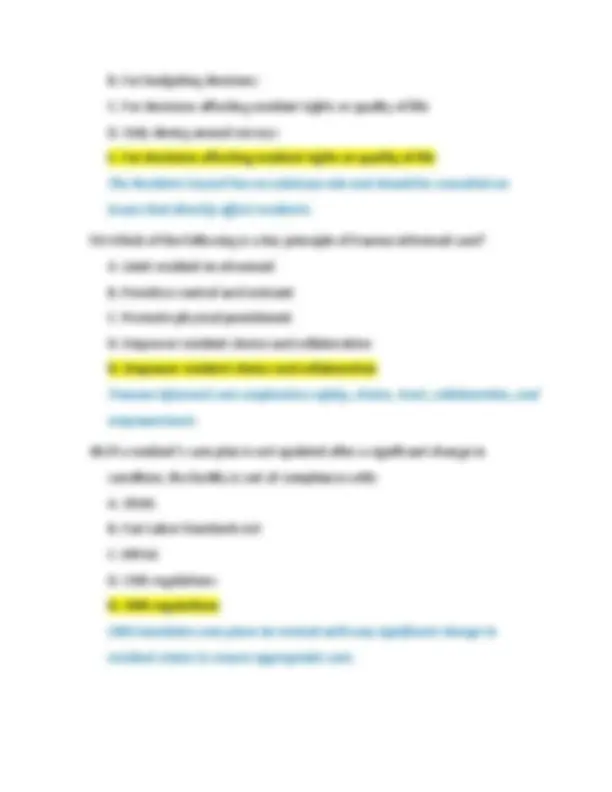
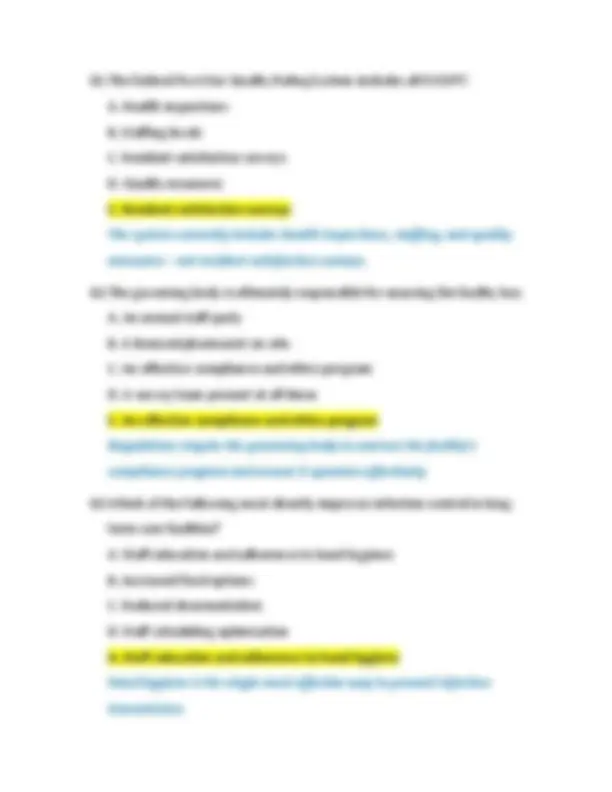
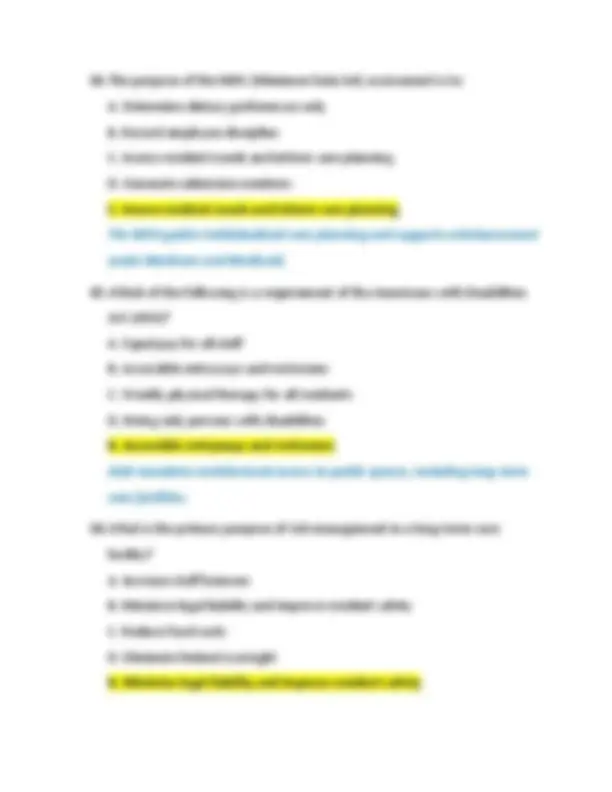
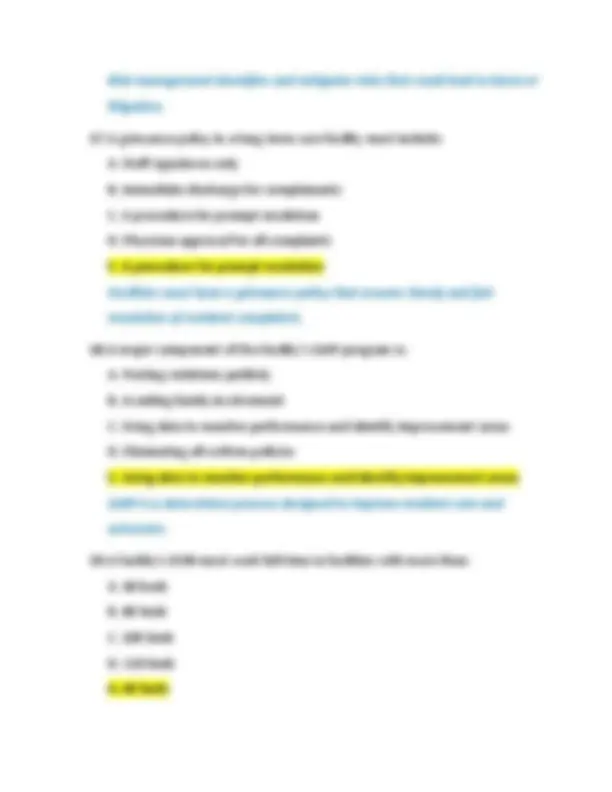
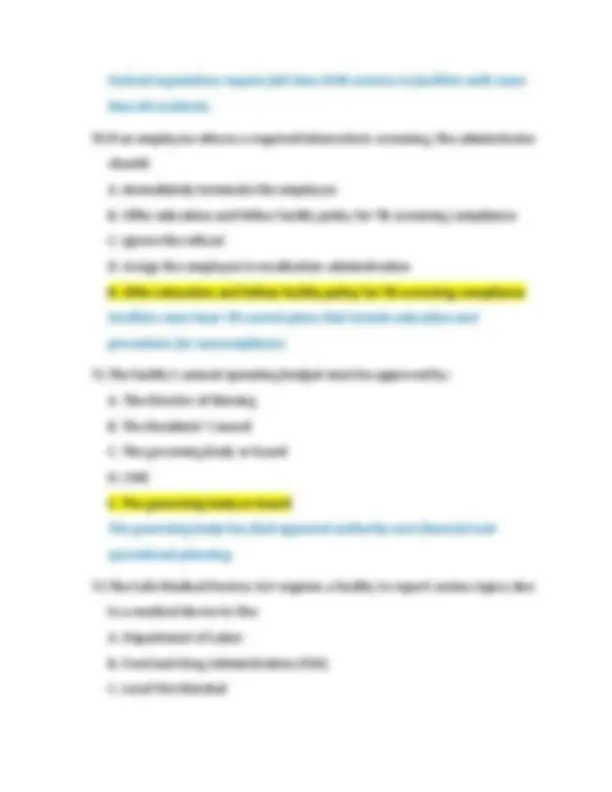
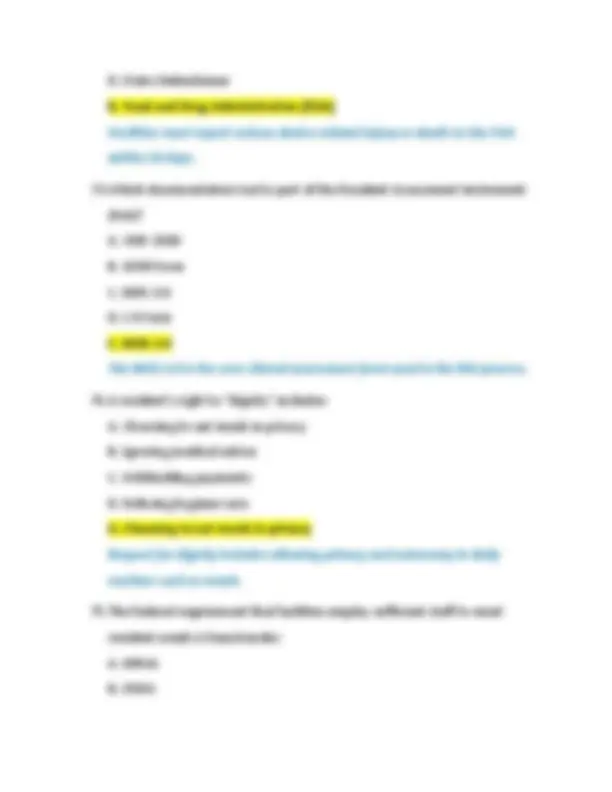
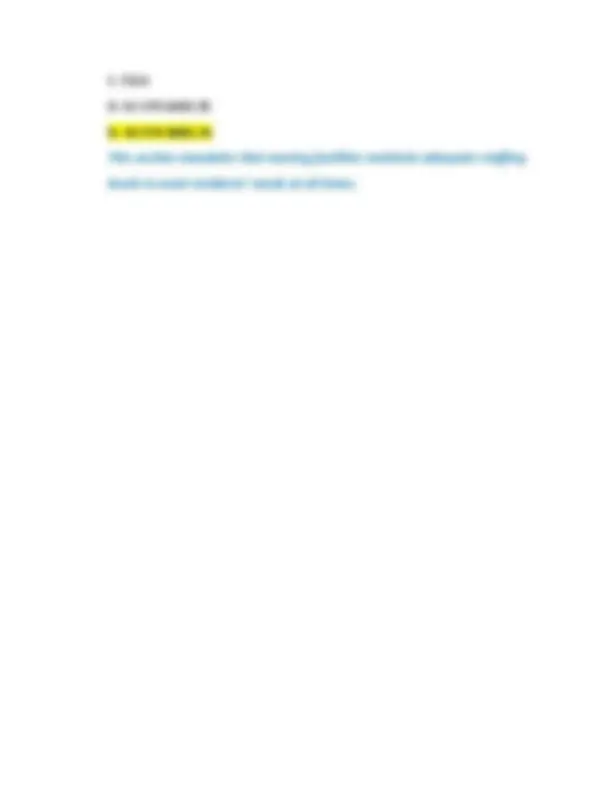


Study with the several resources on Docsity

Earn points by helping other students or get them with a premium plan


Prepare for your exams
Study with the several resources on Docsity

Earn points to download
Earn points by helping other students or get them with a premium plan
Community
Ask the community for help and clear up your study doubts
Discover the best universities in your country according to Docsity users
Free resources
Download our free guides on studying techniques, anxiety management strategies, and thesis advice from Docsity tutors
Minnesota Board of Executives for Long-Term Services & Supports (BELTSS) licensing exam Questions And Correct Answers (Verified Answers) Plus Rationales 2025 Q&A | Instant Download
Typology: Exams
1 / 29

This page cannot be seen from the preview
Don't miss anything!






















Age 21 aligns with national NAB standards and ensures applicants have completed requisite education.
B. Diagnosis Related Group (DRG) C. Resource-Based Relative Value Scale (RBRVS) D. Capitation under Managed Care A. Prospective Per-Diem Case Mix Minnesota’s blended system sets facility-specific daily rates adjusted for resident case-mix classifications derived from MDS data. 11.Non-profit long-term care facilities in Minnesota must file IRS Form 990 by the 15th day of the ___ month after the end of their fiscal year. A. 3rd B. 4th C. 5th D. 6th C. 5th Form 990 is due on the fifth-month anniversary (e.g., May 15 for a December-31 year-end), assuring transparency and tax-exempt compliance. 12.Under OSHA’s Bloodborne Pathogens Standard, an Exposure Control Plan must be reviewed and updated at least: A. Monthly B. Quarterly C. Annually D. Every two years C. Annually Annual review ensures incorporation of new tasks, devices, and safer practices to protect staff.
C. Assign a licensed nurse to monitor every dose D. Lock all self-medications in central storage A. Obtain a physician’s order and assess the resident’s ability Assessment and physician consent balance resident autonomy with safety. 16.The minimum resident record retention period specified by Minnesota rules for nursing facilities is: A. 2 years after discharge B. 3 years after discharge C. 5 years after discharge D. 10 years after discharge C. 5 years after discharge Five-year retention supports continuity of care, legal defense, and regulatory review. 17.For fire safety, the NFPA 101 Life Safety Code requires unsprinklered nursing facilities built before 2016 to conduct fire drills at least: A. Monthly on each shift B. Quarterly on each shift C. Semiannually D. Annually B. Quarterly on each shift Quarterly drills on all shifts ensure staff readiness under varying conditions.
18.During an annual survey, inspectors cite an F-tag at Scope/Severity level F. This indicates: A. Immediate Jeopardy to resident health or safety B. Isolated deficiency causing no actual harm but potential for more than minimal harm C. Pattern deficiency causing actual harm that is not immediate jeopardy D. Widespread deficiency causing no harm C. Pattern deficiency causing actual harm that is not immediate jeopardy Level F equates to actual harm of a pattern nature (multiple residents/situations) without Immediate Jeopardy. 19.The administrator wants to reduce antipsychotic medication rates. Which CMS initiative directly supports this goal? A. Five-Star Quality Rating System B. Partnership to Improve Dementia Care C. QIO Quality Measure Campaign D. Value-Based Purchasing Program B. Partnership to Improve Dementia Care Launched in 2012, the initiative focuses on person-centered care and non-pharmacological interventions to reduce unnecessary antipsychotic use. 20.Minnesota’s “Safe Patient Handling” statute requires long-term care facilities to: A. Provide mechanical lifts in every resident room B. Establish a written program and committee with direct-care staff participation
23.A resident’s responsible party demands access to electronic health records (EHR) within four hours. HIPAA allows up to ____ days to provide access if records are kept onsite. A. 1 day B. 5 days C. 10 days D. 30 days D. 30 days The Privacy Rule permits up to 30 days (with a single 30-day extension) to fulfill a records request. 24.The federal minimum data set (MDS) contains which core item for resident cognition? A. PHQ-9 score B. C0100 Speech Clarity C. BIMS (Brief Interview for Mental Status) D. T-score for delirium risk C. BIMS (Brief Interview for Mental Status) BIMS assesses memory and orientation, driving care planning and quality metrics. 25.During financial review, the administrator notes the facility’s current ratio is 0.9. This indicates: A. Strong liquidity B. Potential short-term cash flow problems C. Excess working capital D. A net operating surplus
B. Potential short-term cash flow problems A current ratio below 1 suggests liabilities exceed current assets, risking ability to meet short-term obligations. 26.Under Minnesota law, the governing body of a licensed nursing home must meet at least: A. Monthly B. Quarterly C. Semiannually D. Annually D. Annually The governing body must meet at least annually to review facility operations and ensure compliance with licensure requirements. 27.Which agency is responsible for certifying nursing homes for participation in the Medicare and Medicaid programs in Minnesota? A. Minnesota Board on Aging B. U.S. Department of Health and Human Services C. Minnesota Department of Health D. Centers for Disease Control and Prevention C. Minnesota Department of Health MDH conducts certification surveys under contract with CMS to ensure compliance with federal regulations. 28.According to federal law, a nursing facility must notify the resident and representative of a room change at least how many days in advance (unless
Failure to follow a Directed Plan of Correction can lead to severe sanctions, including loss of licensure. 31.A facility must conduct a facility-wide assessment under the Requirements of Participation: A. Once every 5 years B. Annually or upon significant change C. Only when ownership changes D. Only when census changes B. Annually or upon significant change This assessment ensures staffing, services, and resources match the resident population and acuity. 32.A nurse aide must complete at least ____ hours of in-service training annually to maintain active status in Minnesota. A. 6 B. 8 C. 12 D. 16 C. 12 Federal and state law require at least 12 hours of annual in-service education for nurse aides. 33.Which entity regulates the use and storage of hazardous chemicals in long- term care facilities? A. EPA B. OSHA
The Occupational Safety and Health Administration governs chemical safety through the Hazard Communication Standard. 34.A facility’s infection preventionist must have which of the following qualifications under CMS rules? A. Registered dietitian license B. Completion of specialized training in infection control C. Medical degree D. Certified Activities Director credential B. Completion of specialized training in infection control CMS requires infection preventionists to have training appropriate to the role, including coursework or certification. 35.Which financial statement shows the facility’s revenues and expenses over time? A. Balance Sheet B. Income Statement C. Statement of Cash Flows D. Trial Balance B. Income Statement The income statement (also known as profit and loss) details income and expenditures for a specific time period.
The Vulnerable Adults Act mandates reporting within 24 hours of suspicion of abuse, neglect, or exploitation. 39.A facility’s QAPI program should be: A. Led solely by the Director of Nursing B. Developed but not documented C. Comprehensive and data-driven D. Conducted quarterly by the owner C. Comprehensive and data-driven QAPI must use data, root cause analysis, and interdisciplinary input to improve quality systematically. 40.Under the Americans with Disabilities Act (ADA), facilities must ensure: A. All staff are under 60 years old B. Resident rooms are restricted by diagnosis C. Equal access to services for individuals with disabilities D. Limited family visitation C. Equal access to services for individuals with disabilities The ADA prohibits discrimination and ensures accessibility to healthcare services. 41.The administrator suspects falsified documentation in a nurse’s progress notes. What is the most appropriate first step? A. Fire the nurse immediately B. Report to the resident council C. Conduct an internal investigation D. Ignore the concern unless a family member complains
C. Conduct an internal investigation Proper procedure includes investigating the concern before taking disciplinary or legal action. 42.The Medical Director’s responsibilities include all EXCEPT: A. Serving as liaison with attending physicians B. Leading daily nursing shift meetings C. Advising on medical policies D. Oversight of clinical care quality B. Leading daily nursing shift meetings Daily operational duties like shift reports are typically the responsibility of nursing management. 43.Which is a primary purpose of the Life Safety Code (NFPA 101) in long-term care facilities? A. Ensuring dietary compliance B. Regulating infection control C. Minimizing fire and life safety hazards D. Preventing medication errors C. Minimizing fire and life safety hazards The Life Safety Code sets construction, egress, and equipment standards to ensure fire safety. 44.When a facility’s census exceeds licensed capacity, the administrator must: A. Ignore the overage unless the state contacts them B. Discharge residents C. Report to the Department of Health and rectify immediately
C. All essential personnel D. Volunteers only C. All essential personnel A comprehensive disaster plan includes roles and responsibilities of all staff critical to emergency operations. 48.The facility’s petty cash fund is used primarily for: A. Large equipment purchases B. Daily resident activities C. Minor, incidental expenses D. Administrator’s travel reimbursements C. Minor, incidental expenses Petty cash is intended for small operational expenses like postage, office supplies, or emergency purchases. 49.When billing for Medicare Part A, the facility must submit data from the: A. Uniform Hospital Discharge Data Set (UHDDS) B. MDS 3. C. RAI User’s Manual D. PHQ- 9 B. MDS 3. The Minimum Data Set is used to calculate the PDPM payment rates under Medicare Part A. 50.In the event of a resident’s death, the facility must notify the family or legal representative: A. Within 24 hours
B. Immediately C. Within 3 business days D. Only upon written request B. Immediately Prompt notification of death is required to support families and fulfill ethical and regulatory obligations. 51.Under Minnesota rules, the facility must provide residents with written notice of transfer or discharge at least: A. 24 hours in advance B. 48 hours in advance C. 15 days in advance D. 30 days in advance D. 30 days in advance State and federal regulations require at least 30 days' written notice, except in cases of emergency or health/safety risks. 52.Who has the primary responsibility for verifying the licensure status of a newly hired RN in a Minnesota nursing facility? A. The Director of Nursing B. The Staffing Coordinator C. The Human Resources Department D. The Administrator C. The Human Resources Department